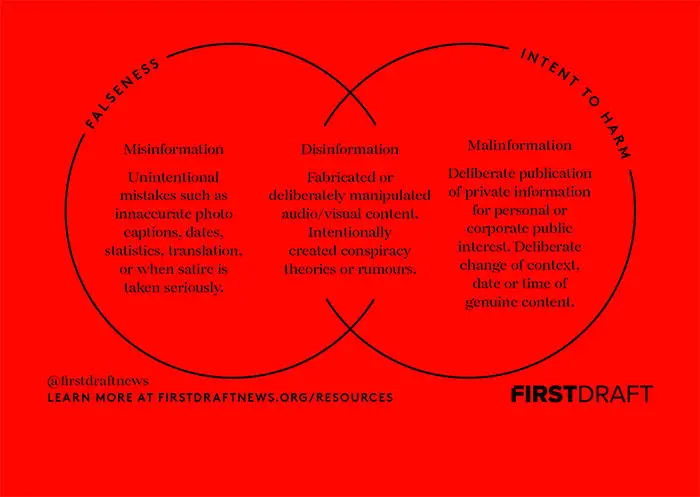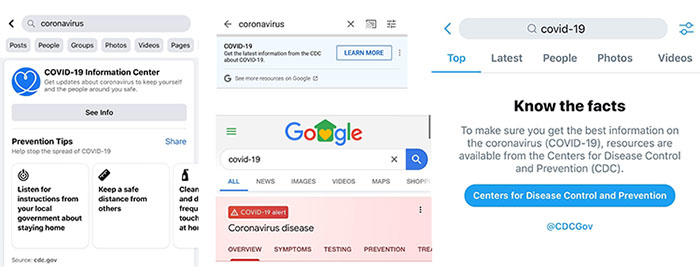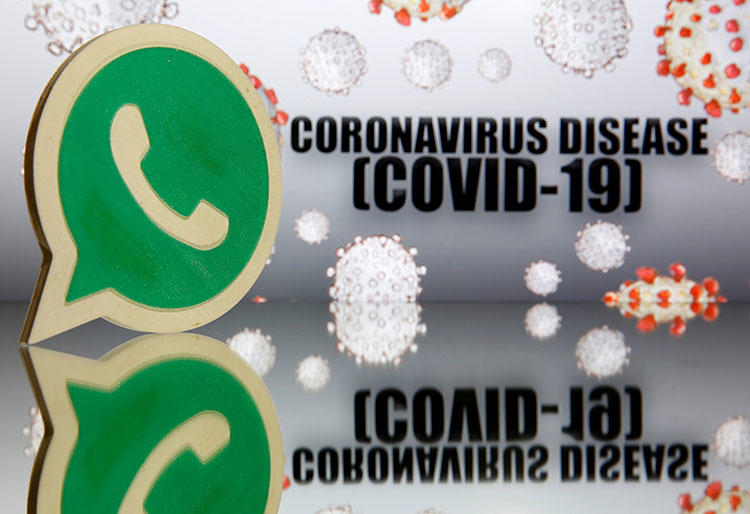While digital communication enables the public to receive critical information about the COVID-19 pandemic in real time, the same tools are enabling an “infodemic” of misinformation that “can hamper an effective public health response and create confusion and distrust,” according to the United Nations.
Fact-checkers are facing “the biggest challenge [they] have ever faced,” according to Reuters Institute for the Study of Journalism at the University of Oxford (RISJ), which reported in April that “the number of English-language fact-checks rose more than 900% from January to March” 2020 due to misinformation around the virus.
The international nonprofit research center First Draft provides resources in multiple languages to help journalists identify and report on mis- and disinformation, including on COVID-19.

“Our mandate in the U.S. is to help local newsrooms figure out disinformation in 2o20,” First Draft’s U.S. deputy director Aimee Rinehart told CPJ via video call in late April. “We thought that would be primarily around the census and the election, and now, it’s like everything else is coronavirus.”
Rinehart told CPJ about the global patterns of misinformation about the coronavirus, and how newsrooms and social platforms are responding to it. The interview has been edited for length and clarity.
What has First Draft been working on since the COVID-19 outbreak began?
We very quickly made our entire output to be around coronavirus, and part of that output is an online course for journalists who are covering coronavirus and a suite of webinars in multiple languages. We try and support journalists with topics that might be of interest to them that would be helpful around the pandemic. We also have an online community where we are sharing daily insights.
We’re trying to map the patterns of how disinformation really corresponds with the outbreak. For example, the outbreak seemed to be about five days behind in the U.K., we had the 5G rumor one week [in the U.S.], and five days later, the rumor was there. And the language around the reopen protests in the U.S. has been recycled in Australia.
[Editor’s note: According to Full Fact, a U.K. fact-checking charity, a now-deleted Facebook post claimed that Wuhan, China–the center of the new coronavirus outbreak–was where 5G was first rolled out. It suggests that 5G has damaged peoples’ immune systems and so boosted the virulence of the common cold. 5G is the next generation of wireless network technology, following on from 4G, and there is no evidence that 5G can harm humans, or their immune systems. Moreover, “we don’t know if [Wuhan] was the first [place with 5G trials],” according to Full Fact.]
It is fascinating to be able to see it from above, to map these patterns and in some ways anticipate what the next country may be seeing, [so] journalists and newsrooms aren’t always on the backfoot of a rumor or conspiracy theory.
Are there any other patterns of misinformation related to this virus that you noticed?
A real distrust of institutions, whether that’s the medical community, scientists, government officials, government bodies like the WHO, the media, and individuals like the director of the WHO and Bill Gates who has been attacked by anti-vaxxers.
There is an erosion of trust on who is telling truth and what should we really be doing.

From your discussions with journalists in the U.S. and around the world, can you give an overview of how the pandemic is affecting newsrooms?
We are seeing local newsrooms tumble [go out of business] all over the world like in India, the U.K., the U.S. and Brazil. Newsrooms really have to reevaluate their business models, so that when something like this happens again, they would have diversified funding streams [beyond advertising].
It is [also] hard to get close to people physically, so [some] stories will be harder to come by. The public sometimes feel safer with numbers, [but] I worry about the reliance on those numbers instead of the personal stories that really illustrate the suffering this has caused, the confusion the pandemic has caused, and the concern for the future.
What should reporters do to make sure they are protected in the times of coronavirus?
Journalists need to know their limits. [If a journalist is] immunocompromised or has some kind of lung impairment, they shouldn’t be out on the front lines.
With that said, there are plenty [journalists] can do digitally in terms of understanding how their community is absorbing coronavirus and explaining [it] to each other, whether it’s joining Facebook groups or joining Nextdoor groups. [In our own research, we use] CrowdTangle, Spike by NewsWhip, Tweetdeck and boolean queries, and we also do manual review of Facebook groups to see what’s out there and try to anticipate [what’s coming]. We would like to receive more tips [from journalists].
Journalists should use a strong unique password for each website or service and strong privacy settings. A lot of journalists will say, “I want to be safer online, but some of those measures can be cumbersome and time consuming,” so they put it off. But you’ve got to keep your sources safe, and by extension, you have to be safe.
Read CPJ’s digital safety kit for journalists
In your opinion, how mis- and disinformation make the press unsafe? And how should reporters be thinking about misinformation in terms of their personal safety?
It depends on how deeply a reporter goes into disinformation spaces, and how much they protect themselves and by extension their sources. Newsrooms need to set rules.
I think it is really critical for journalists to understand how this space works, because they are targets of mis- and disinformation actors who want to fool and manipulate them. Sometimes, it is to discredit all media, sometimes it’s for a laugh, sometimes it’s for money, and sometimes it’s a combination of those three things. It’s a matter of taking one short online course to understand what some of those levers are, because if you are a journalist, it is really important [that you] know some of the major tactics and themes of disinformation tactics.
Reporting on misinformation is challenging in terms of security, and also because you don’t want to make new recruits for a cause and you don’t want to make something bigger than it is.
Are there any unique challenges facing journalists and fact-checkers around COVID-19 mis- and disinformation?
What was true last month was true then, but now we know something different. Each week there is something new, and this is really challenging to communicate to the public. Within that space of uncertainty, there is an opportunity for disinformation actors to go to work and fill any gap that is left.
I was really moved by [reporter] Sarah Maslin Nir’s Twitter thread about recovering from coronavirus, and what she knew at the beginning of March versus what she knows now and how she would have approached it differently.
Are there challenges around researching COVID-19 misinformation that are unique from other misinformation research?
What once was open online communities have now gone into closed spaces. A lot of the stuff we can’t see because it is on closed messaging apps like WhatsApp, Facebook Messenger, Signal and Telegram, with the exception of open Telegram groups. That is the challenge.
As the pandemic matures, so too does the types of mis- and disinformation.
First Draft’s coronavirus debunk archive is searchable in over two dozen languages. Are there any clues or patterns into why and how mis- and disinformation might travel from one language to another or from one country to another?
An app like WhatsApp is very pernicious and can be incredibly problematic in terms of information jumping from a country to country, given how easy it is to exchange information on the app.
In the beginning of the pandemic, lots of the misinformation [about stocking up on food or toilet paper] could have been chain emails in the 1990s. [These messages were] sent without fact-checking, but out of love…that can persuade lots of people.
[Such misinformation] is not completely innocent, but it is not as harmful as trying to sow doubt in vaccinations or in people who are trying to work toward a solution, or at least get out the information to a variety of populations and languages, like the WHO could do.
Are there any patterns that came to your attention in how authorities around the world are responding to misinformation around coronavirus?
Some countries see [the virus] as an opportunity to crackdown [on the press], and that is our concern. It is unevenly patrolled and unevenly prosecuted. It is a hard thing to legislate and I think it is a hard thing to prosecute.
Have you documented any disinformation operations around the virus that was solely orchestrated to discredit the news media?
No, but I don’t necessarily think we need a big campaign, especially with the Trump administration. Unlike any other [U.S.] administration in the past, it’s been this slow and steady erosion of the press…asserting they are fake news. Bolsonaro does that in Brazil; he says if I didn’t say it on Twitter, it didn’t come from me. He is cutting out the press altogether.
This has been a slow build, and now we are in a perfect storm for all of this. It’s been four years of tearing down the press. The business model for news media has never been [so] fractured, so there is less media around now than before, especially on the local market. And all you need is one of the big outlets to make a mistake, and then, there you go, “it is the fake news media.” The discrediting of [the] media was all sort of a trial run for what we are dealing with now.

How do you rate the platforms’ response to coronavirus and what else should they be doing?
I have seen better behavior and citizenship from all of the [major] platforms over the past six months. Their response has been pretty good overall. It is not perfect, but what I appreciate is that they haven’t stopped trying to iterate updates [like from the U.S. Centers for Disease Control and Prevention and the WHO] that are really helpful to the public. So, there are efforts [from the platforms] to rise up quality information and to root out problematic posts. They have been united, and whenever we see collaboration among big tech, it can really be a great thing.
We always want to have more transparency from the platforms in terms of their rules and their enforcement of the rules.
Why were the platforms more proactive in taking action against COVID-19-related misinformation compared to political misinformation?
Well, it is an easier topic than politics. The platforms deeply don’t want to be seen as partisan. But as…the economy reopens, there will be more politicization, and so what was once two different buckets, politics and pandemic, will probably merge into one.
Read CPJ’s Safety Advisory on covering the coronavirus pandemic, available here in over 35 languages.
